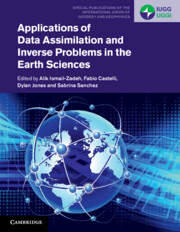Book contents
- Applications of Data Assimilation and Inverse Problems in the Earth Sciences
- Series page
- Applications of Data Assimilation and Inverse Problems in the Earth Sciences
- Copyright page
- Contents
- Contributors
- Preface
- Acknowledgements
- Part I Introduction
- Part II ‘Fluid’ Earth Applications: From the Surface to the Space
- Part III ‘Solid’ Earth Applications: From the Surface to the Core
- 11 Trans-Dimensional Markov Chain Monte Carlo Methods Applied to Geochronology and Thermochronology
- 12 Inverse Problems in Lava Dynamics
- 13 Data Assimilation for Real-Time Shake-Mapping and Prediction of Ground Shaking in Earthquake Early Warning
- 14 Global Seismic Tomography Using Time Domain Waveform Inversion
- 15 Solving Larger Seismic Inverse Problems with Smarter Methods
- 16 Joint and Constrained Inversion as Hypothesis Testing Tools
- 17 Crustal Structure and Moho Depth in the Tibetan Plateau from Inverse Modelling of Gravity Data
- 18 Geodetic Inversions and Applications in Geodynamics
- 19 Data Assimilation in Geodynamics: Methods and Applications
- 20 Geodynamic Data Assimilation: Techniques and Observables to Construct and Constrain Time-Dependent Earth Models
- 21 Understanding and Predicting Geomagnetic Secular Variation via Data Assimilation
- 22 Pointwise and Spectral Observations in Geomagnetic Data Assimilation: The Importance of Localization
- Index
- References
18 - Geodetic Inversions and Applications in Geodynamics
from Part III - ‘Solid’ Earth Applications: From the Surface to the Core
Published online by Cambridge University Press: 20 June 2023
- Applications of Data Assimilation and Inverse Problems in the Earth Sciences
- Series page
- Applications of Data Assimilation and Inverse Problems in the Earth Sciences
- Copyright page
- Contents
- Contributors
- Preface
- Acknowledgements
- Part I Introduction
- Part II ‘Fluid’ Earth Applications: From the Surface to the Space
- Part III ‘Solid’ Earth Applications: From the Surface to the Core
- 11 Trans-Dimensional Markov Chain Monte Carlo Methods Applied to Geochronology and Thermochronology
- 12 Inverse Problems in Lava Dynamics
- 13 Data Assimilation for Real-Time Shake-Mapping and Prediction of Ground Shaking in Earthquake Early Warning
- 14 Global Seismic Tomography Using Time Domain Waveform Inversion
- 15 Solving Larger Seismic Inverse Problems with Smarter Methods
- 16 Joint and Constrained Inversion as Hypothesis Testing Tools
- 17 Crustal Structure and Moho Depth in the Tibetan Plateau from Inverse Modelling of Gravity Data
- 18 Geodetic Inversions and Applications in Geodynamics
- 19 Data Assimilation in Geodynamics: Methods and Applications
- 20 Geodynamic Data Assimilation: Techniques and Observables to Construct and Constrain Time-Dependent Earth Models
- 21 Understanding and Predicting Geomagnetic Secular Variation via Data Assimilation
- 22 Pointwise and Spectral Observations in Geomagnetic Data Assimilation: The Importance of Localization
- Index
- References
Summary
Abstract: The primary observables of the Global Positioning System (GPS) ground tracking sites for geodynamics are the Earth’s surface motions, and their geophysical interpretation is based on the numerical models of various tectonic processes. The key issues for geophysical interpretation of the GPS observations are adequate mechanical models of brittle and ductile rock behaviour used to predict surface motions related to various tectonic processes, and the corresponding inversion techniques which allow separation of the processes, and evaluation of their parameters. For large-scale heterogeneous processes, the inversion of the GPS observations requires regularisation because it implies evaluation of some complicated distributed underground motions from their discrete manifestation at the surface. One of the fastest growing applications of the satellite geodetic observations is investigation of the seismotectonic deformation associated with great earthquakes worldwide at all stages of the seismic cycle – inter-seismic, co-seismic, post-seismic. The inversion techniques based on dislocation models in elastic or viscoelastic medium is one of the approaches that may be widely used for GPS-based studies of various seismotectonic deformations.
Keywords
- Type
- Chapter
- Information
- Publisher: Cambridge University PressPrint publication year: 2023
References
- 2
- Cited by

